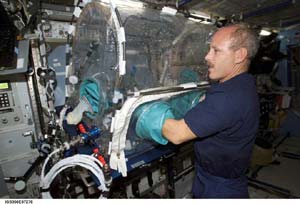
Research continues in an effort to determine if these neural cells can be transplanted to treat stroke, brain tumors and neurodegenerative disorders
Researchers at Cedars-Sinai’s Maxine Dunitz Neurosurgical Institute have for the first time demonstrated that stem cells from whole adult bone marrow can be differentiated into several types of cells of the central nervous system.
A long-term objective of this research is to determine if these neural stem cells can be trans

Scientists are still learning what’s in a drop of ocean water, according to this week’s Nature Magazine. And the answers have implications for the whole planet, says co-author Craig Carlson, an oceanographer at the University of California, Santa Barbara. Carlson is an assistant professor in the Department of Ecology, Evolution and Marine Biology.
About ten thousand bacterioplankton of the type SAR 11 are found in every drop of seawater. And yet, as explained in the article, which

Changes to farming practices in rice paddies in China may have led to a decrease in methane emissions, and an observed decline in the rate that methane has entered the Earth’s atmosphere over the last 20 years, a NASA-funded study finds.
Changsheng Li, a professor of natural resources in the University of New Hampshire’s Institute for the Study of Earth, Oceans, and Space, and lead author of the study, notes that in the early 1980s Chinese farmers began draining their paddies midw

The Zeolite Crystal Growth (ZCG) experiment got off to a successful start this week aboard the International Space Station.
Hard as a rock, yet able to absorb liquids and gases like a sponge, zeolites form the backbone of the chemical processes industry. Virtually all the world’s gasoline is produced or upgraded using zeolites. Improving zeolites could make gasoline production more efficient or lead to ways of storing clean-burning hydrogen for fuel. Zeolites can also be applied to

What’s seven feet long, 250 million years old, and currently lurking in the depths of Oregon’s Rogue River? It’s the green sturgeon, the craggy, shark-like fish that has quietly eked out a living since the time of the dinosaurs. But according to a new study published by researchers from the Bronx-Zoo based Wildlife Conservation Society and other groups, this living fossil is extremely vulnerable to both overfishing and habitat alteration such as water diversion for irrigation and pollu

Researchers at Washington University School of Medicine in St. Louis have discovered a possible new mechanism for regulating large groups of genes. While conducting yeast research on a potential new anticancer drug, the team identified a mechanism that enables the genome to silence large numbers of genes simultaneously, rather than each gene individually.
The finding emerged during research studying the molecular action of the drug rapamycin. Rapamycin currently is used to suppress the immu

An international team that includes the University of Bath has discovered three ultra-massive galaxies (‘Red Monsters’) in the early Universe forming at unexpected speeds, challenging current models of galaxy formation….

An international team of researchers led by scientists from the Facility for Rare Isotope Beams uncovered evidence that astrophysics models of massive stars and supernovae are inconsistent with observational gamma-ray…

… could change how we use and control light. The new discovery could dramatically enhance technologies like lasers, sensors and optical computing in the near future. An international research team…

Rice researchers develop novel electrochemical reactor. A team of Rice University researchers led by Lisa Biswal and Haotian Wang has developed an innovative electrochemical reactor to extract lithium from natural…

… may soon be on your plate. The protein in sea lettuce, a type of seaweed, is a promising complement to both meat and other current alternative protein sources. Seaweed…

…gives crop breeders a wider lens. Understanding how both environmental conditions and genetic makeup affect crops is essential to developing varieties that are more resilient and productive. But the intricate…

New ISTA assistant professor Julian Léonard makes abstract quantum properties visible. From the realm of the abstract to the tangible, the new assistant professor at the Institute of Science and…

Engineers in Australia have found a way to make stronger and crack-resistant concrete with scrap carpet fibres, rolling out the red carpet for sustainability in the construction sector. The research…
With the increase of new technology and artificial intelligence, the demand for efficient and powerful semiconductors continues to grow. Researchers at the University of Minnesota have achieved a new material…

Carnegie Mellon University’s EgoTouch creates simple interfaces for virtual and augmented reality. The new generation of augmented and virtual reality controllers may not just fit in the palm of your…

Physicists create “light hurricanes” that could transport huge amounts of data. Much of modern life depends on the coding of information onto means of delivering it. A common method is…

A new approach to beam shaping will soon make additive manufacturing more flexible and efficient: Fraunhofer ILT has developed a new platform that can be used to individually optimize laser…